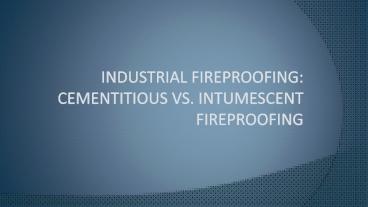Industrial fireproofing - PowerPoint PPT Presentation
Title:
Industrial fireproofing
Description:
Fireproofing needs to be durable to survive the rigors of everyday life in the plant so that if and when a fire does occur, the fire endurance properties have been maintained and the fireproofing can be depended on to function satisfactorily. Everyday exposure may involve mechanical abuse, exposure to oil, solvents, and chemicals, and outdoor weathering for prolonged periods of twenty, thirty, forty years or more. – PowerPoint PPT presentation
Number of Views:332
Title: Industrial fireproofing
1
Industrial fireproofing Cementitious vs.
intumescent fireproofing
2
- an industrial fireproofing strategy is a
prerequisite for being able to secure affordable
insurance. But despite being just short of
mandatory for many businesses, straight advice on
what type of industrial fireproofing strategy to
pursue can be hard to come by. Many online
sources tend to dispense advice that seems
curiously tailored to their own product lines
upon closer inspection.
3
Active vs. passive fire protection
- Two terms that come up often in discussions of a
facilitys fire protection are active and
passive fireproofing. Active fireproofing (AFP)
measures are all of those that require some type
of action, either triggered by ambient conditions
or an individual, in order to be effective.
Examples of AFP include the kicking on of a
sprinkler system or a staff member using a fire
extinguisher to try to put out a small blaze.
Your local fire department and the brave work
they do is perhaps the finest example of AFP. - Passive fire protection (PFP), on the other hand,
refers to building design elements and planned
safety measures meant to control the spread of a
fire. PFP can help to mitigate the potentially
disastrous effects of failed AFP measures, like
broken sprinklers or an extinguisher that hasnt
been inspected or replaced in a timely manner.
Examples of PFP measures can include room
compartmentalization to prevent a fires spread,
fire doors to limit the spread of smoke and, most
importantly for our purposes, a fire-resistant
coating that helps to protect structural steel
and limit damage to critical infrastructure.
4
- One strategy is never a substitute for the other,
but PFP can help to hedge against unexpected AFP
measures and to buy time for them to kick into
effect, hopefully helping to alleviate the
effects of a fire event within a facility. Now
we can take a look at what sets two of the most
common types of PFP, cementitious and intumescent
coatings, apart from one another and which
factors should determine their use
5
Cementitious or intumescent coatings?
- Lightweight cementitious coatings have their
origins in the dense concrete that was often used
to fireproof industrial facilities up until
around the mid-twentieth century. Cheap and
resistant even to very high temperatures, dense
concrete was eventually superseded by
cementitious coatings that were not quite as
heavy (and hence were cheaper and easier to
apply) once the technology developed. - Today cementitious coatings remain relatively
inexpensive materials for the fireproofing of
facilities. Though labor does have the potential
to drive up the cost of these jobs, since they
must be applied in several, successive layers,
they are still well-suited for dry environments
where the substrate is not expected to be exposed
to heavy vibrations and/or impact.
6
- Where they should not be used is in environments
with high ambient moisture levels, since
cementitious coatings will inevitably create a
space between the substrate and the coating
itself. This space is ideal for moisture to
settle and for the process of corrosion under
fireproofing (CUF) to set in. - Intumescent coatings operate on a different
principal, however. Rather than forming a
relatively thick physical barrier between the
flames and the steel they protect, as
cementitious coatings do, intumescents
intumesce, or char and expand, when exposed to
extreme heat. The coating literally grows as a
means of forming the type of barrier that
cementitious coatings maintain regardless of
temperature. By increasing in volume and
decreasing in density, intumescents slow the
heating of steel and prolong the possible
response time before a significant failure or
collapse occurs.
7
Fire-Proof Applicator of Steel Structures
- Building regulations require certain elements of
a structure to have fire resistance. Whether or
not an element requires fire resistance depends
on the size the building, what it will be used
for and what the function of the element is. - When exposed to fire, all commonly used
structural materials lose some of their
mechanical strength. Heavily loaded steel will
lose its designed safety margin at temperature
around 550C regardless of the grade of steel.
To protect the structural steel in your building,
use PAROC fire protection slabs. Depending on the
application, you can use one of three methods for
fire protection profile, box and solid.
8
- The bigger volume of steel in the exposed area,
the better fire resistance it has. How quickly
the steel structure heats up in a fire can simply
be described as the relation between the surface
exposed to the fire and the steel volume of the
profile. This relation is called the section
factor A/V. A high section factor gives a quick
temperature raise of the steel. In practice, this
means that thin steel structures demand thicker
protection.
9
Fire protection of steel profiles in external
walls with plaster boards
- Sometimes columns in external walls can be
protected from three sides. A 5mm thick RHS
profile, at a critical temperature of 400
600C and with the required fire class R 60, can
be protected from three sides with 20mm thick
PAROC FPS 17. This only can be done in fire class
R60 with two layers of plaster board on the
internal side of the wall. The external side of
the wall has to be covered with thick plaster
board at least 9mm thick. The limitation is that
the steel profiles cant be located next to
openings (windows and doors). The facade also has
to be non-combustible.

